The Sweet Life at Muddy Pond Sorghum in Tennessee & a Recipe for the Best Sorghum Cookies
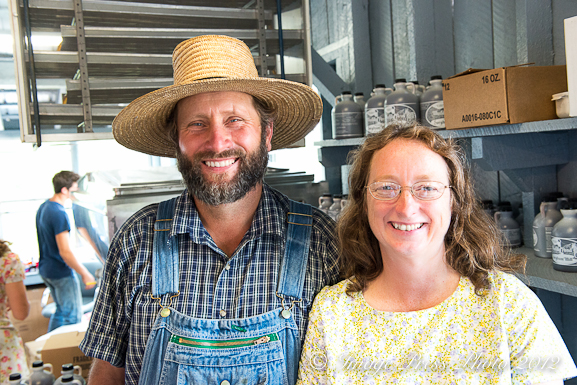
This is where our heart is. This is what we love. – Mark Guenther
Life is sweet in the Muddy Pond community in Tennessee. Sorghum cane planting, harvesting, and syrup-making is not just a business here. It’s a way of life. It’s a passion. It’s about family, fellowship, and community.
Traveling through the winding roads and picturesque foothills of rural Middle Tennessee, Roger and I did not know what to expect from this long anticipated trip to meet with the Guenther family of Muddy Pond Sorghum. As we turned onto Muddy Pond Road, the rolling hills were blanketed with the late summer’s shades of green with stretches of road eerily canopied with draped trees. Muddy Pond Road seemed endless as we drove past quaint general stores and long stretches of fertile farm land.
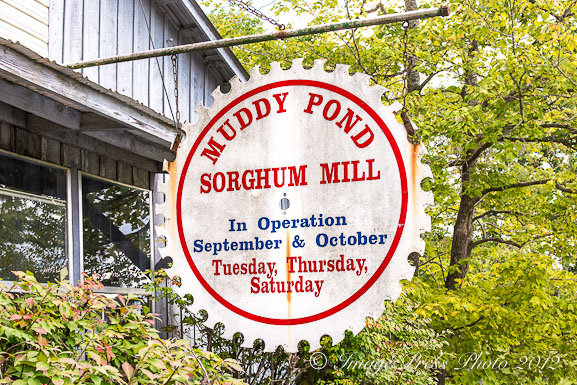
Muddy Pond Sorghum Mill
As we approached the mill, the quiet country road brought us into a bustling center of activity. It was sorghum making day and family, friends, neighbors, and guests from afar were stopping by. We could hear women singing “Down in the River to Pray” through the open windows of the building. A horse-drawn mill, set alongside today’s modern mill, was fed with cane, a 1960s-era truck was parked by the building, and the steam locomotive boiler billowed dark smoke from its chimney. We had arrived, not at a destination, but at a time gone by.
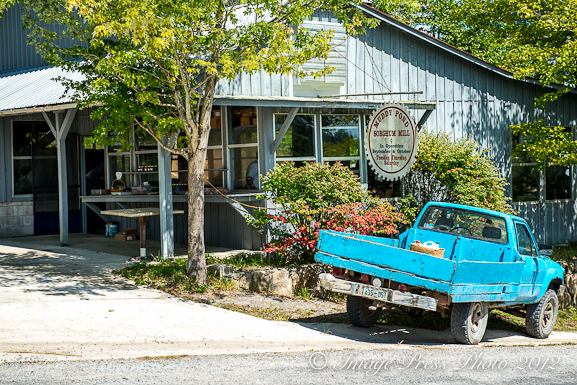
Modern mill and vintage 1960s truck

The steam locomotive engine billows smoke from the chimney
September and October are busy times in the predominately Mennonite Muddy Pond community. The sorghum cane is ready to harvest and the Guenther family opens their mill for production and welcomes the public to learn about the process of making sorghum. It is also the time to get a glimpse of a simpler life in Middle Tennessee where days are filled with family, farm, and chores.
Young children excitedly arrive on farm vehicles and in cars to help out at the mill. Friends and guests come to purchase homemade goods baked that day by women in the Guenther family and to buy freshly made sorghum that is still warm in the bottle. There is a real sense of community as the men gather to talk and strangers spoke to us telling of the good life in this part of Tennessee. With passion in their voice and a peacefulness in their demeanor, I had to believe it was true.
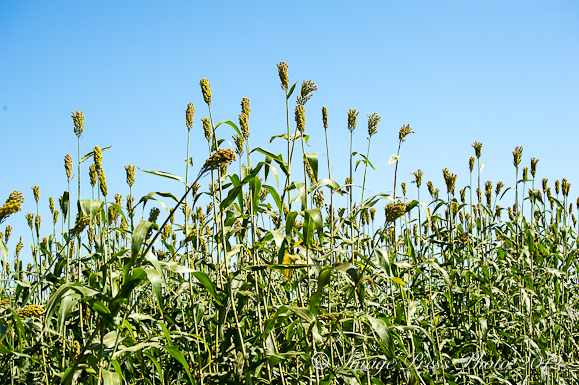
Sorghum cane ready to be harvested
As you enter the mill, the air is filled with the steam from the sorghum making process; at times, it’s so thick, you can barely see across the room. The machinery has a Rube Goldberg appearance as the sorghum juice spews out one end, cascades through a trough, under a gate, through another trough, into a bucket, and pumped to a slide where it’s captured in a bottle.
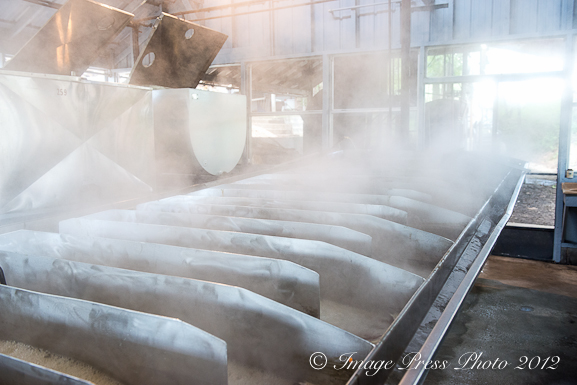
Cooking the sorghum gives off a 90% evaporate from the cane juice
Several generations of families from the community take part in the making of the sorghum syrup. From the oldest, managing the temperature, flow, and skimming of chlorophyll from the hot cane syrup to the teenagers stoking the fire of the boiler, to the youngest members filling the bottles with the warm syrup. They all take turns and rotate responsibilities. There is a sense of community and purpose.
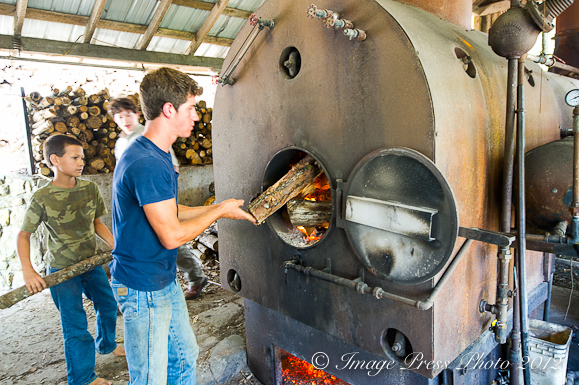
Stoking the boiler
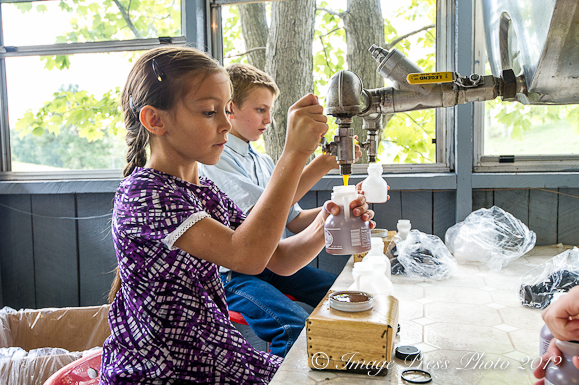
The youngest members help to bottle the sorghum
Sorghum has garnered much attention over the past several years as chefs have sought out local, heirloom, and artisanal ingredients. Dishes are no longer described in simple terms, but rather with a list that proudly states where the ingredient was raised, grown, or produced. As Southern food has become widely popular, sorghum has also become an integral ingredient in recipes across America.
The sweet taste of sorghum is lighter and milder than molasses and a healthier choice than corn syrup. It is high in antioxidants, calcium, and potassium, and it is excellent in baked goods as well as savory dishes.
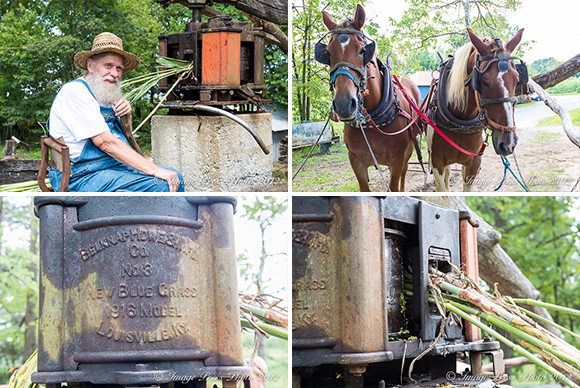
Horse-drawn cane press
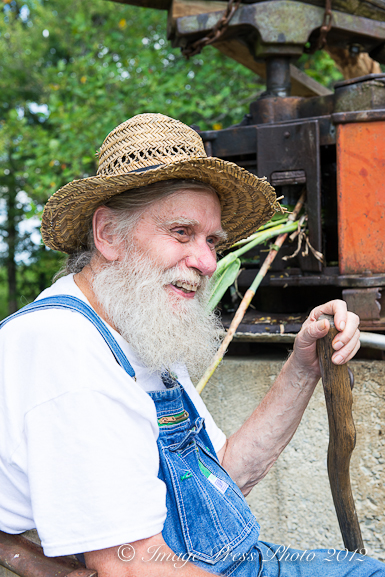
Craig Withman has been sharing the history and story of sorghum making for many years at Muddy Pond
The Guenther family is preserving a product that is important to our American past. Recently, Muddy Pond Sorghum was named one of eleven culinary artisans to be the recipient of the President’s American Treasures Award and was honored at a ceremony at the White House in July. It is truly one of the highest honors for an individual or small producer “in recognition of a singular and significant contribution to our Nation that both preserves and fosters a unique All American craft and tradition.” They are also three-time Grand Champions in the National Sweet Sorghum Producers and Processors Association’s Sorghum Syrup Contest.
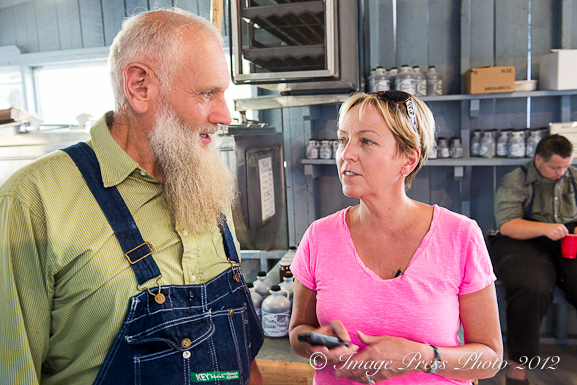
With John Guenther at the mill
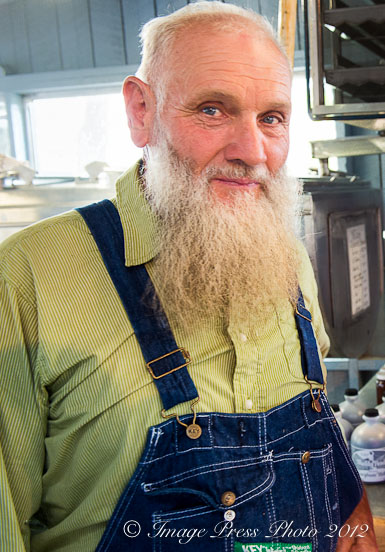
The patriarch of the family, John Guenther
In 1965, John and Emma Guenther moved from Pennsylvania to Tennessee. John, a Lowland Dutchman, from Saskatchewan, Canada, began making sorghum as part of a community effort. At the time, many of the families in the area raised sorghum cane and made syrup together. In 1981 when the rest of the community stopped growing sorghum cane, John began planting and harvesting his own crop. Today, the Guenther family collectively owns thousands of acres. They raise livestock and other crops on their farm. Sixty acres are planted in sorghum. Four out of eight siblings in the Guenther family, their children, and extended family are involved in Muddy Pond Sorghum, however, Mark and Sherry Guenther are the two spokespersons for the business.
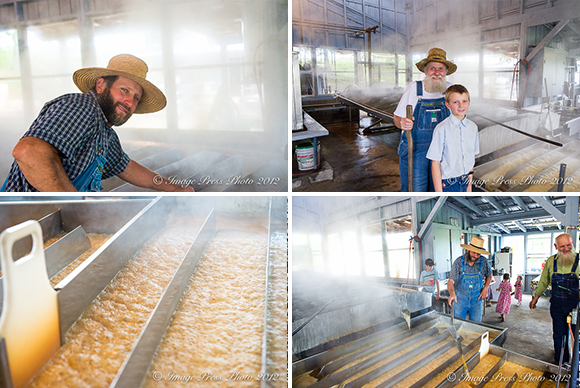
Family and friends of the Muddy Pond community work at the mill
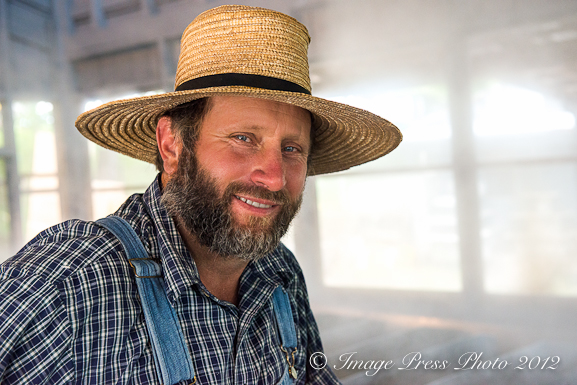
Mark Guenther
As most teenagers, Mark was not initially interested in the hard work that it took to turn sorghum cane into syrup and chose “public work” over the collective family effort. In a short amount of time, Mark realized that the life at Muddy Pond and sorghum making was in many ways better than life outside the community and returned to the fold. He used his skills and talent to build equipment that would automate much of the process and make it easier to cut, juice, and boil the sorghum. Tractors with cane harvesters and built-in mills, pressurized boilers, hydraulic lifts, and pumps have replaced most of the manual effort.
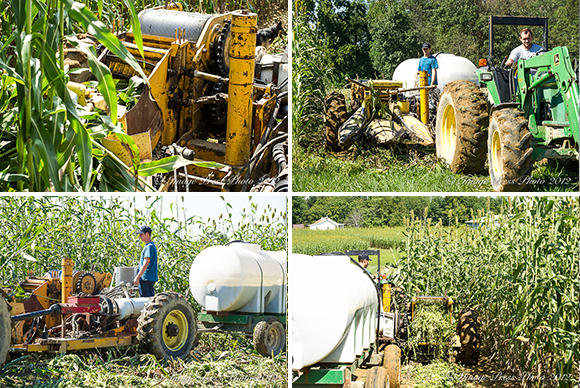
Modern equipment has made harvesting the cane easier
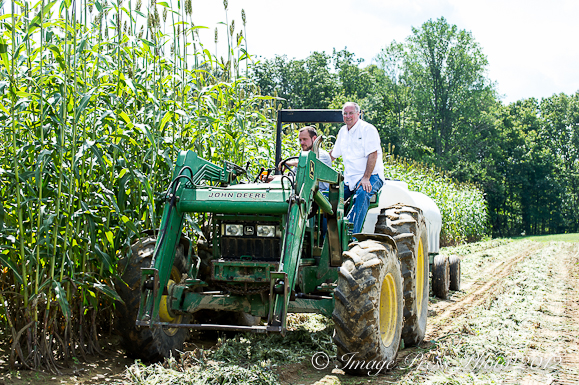
Mr. B relived some of his life on the farm with family in Indiana with Ed Guenther

The seed pod from the cane
The original process of extracting the juice was with a horse-drawn mill, which a few sorghum makers still use today, primarily for demonstration purposes. The extracted cane juice was cooked over an open flame in a large pot or cauldron until it was reduced to a syrup. Because this method was inefficient for making large amounts of sorghum, many producers have developed their own unique methods for sorghum production. This video shows the process Mark and his family invented at Muddy Pond from harvesting the cane in the fields to the bottling at the mill.
Mark and Sherry spend much of their time traveling to festivals and other events with their horses and mules where they demonstrate traditional sorghum making. They have attend the Southern Foodways Alliance Taste of the South gathering at Blackberry Farm each year, dined with the governor of Tennessee, traveled to the Atlanta Food and Wine Festival, and made their way to Washington, D.C., to accept the American Treasures Award. “We are so blessed. Sherry loves it. It is in her heart and soul. We are so happy to go to these places,” Mark told us. Asked if they ever have time for a real vacation, Mark said that these trips are their vacation, however, “It would be nice some day to go somewhere where no one knows who you are and not make a big deal about it.” That probably will not happen any time soon as the popularity of sorghum continues to grow.
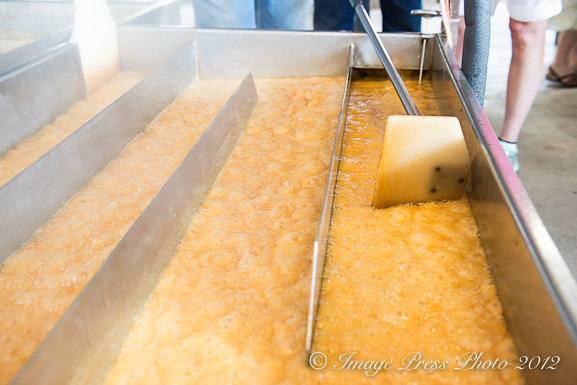
Sorghum boiling down in the finishing pan
The laborious work of the fall harvest is not the end of the hard work for the Guenther family. Everyone has their chores as winter comes and the old sorghum crops are plowed back into the ground. Cover crops will be seeded. Cattle and mules move inside the barns as chilly temperatures creep into the Tennessee foothills. Next spring, as the new crop will be planted the first of May, the manure from the barns will be spread to naturally fertilize the fields.
The Guenther’s most successful sorghum crop to date was this year, 2012. While other parts of the country suffered extreme temperatures and drought, sorghum is a hearty crop. It can also grow in very poor soil. “It’s very resilient,” Mark said. “Until July, it was hot and dry. We were discouraged, but the sorghum cane stands back and waits. t matures over fourteen to twenty days. The rains came and it grew. It was unbelievable. It’s one of our best crops ever. Of course, it’s not done until it is in the jars.”
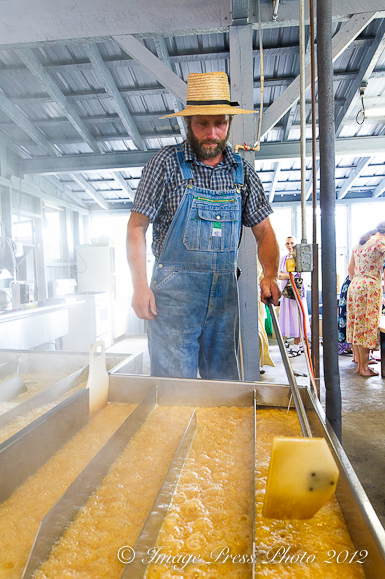
Foaming sorghum syrup just before it drains into a bucket
Muddy Pond Sorghum is one of just a handful of mills in the United States that make sorghum on this scale. They are hoping to produce 10,000 gallons this year. The mill operates three days a week in September and October and during that time they will process one acre of cane per day. During each eight or nine-hour day at the mill, they will boil down 2,400 gallons of juice (from that one acre of cane) to make between 250 to 275 gallons of sorghum syrup.
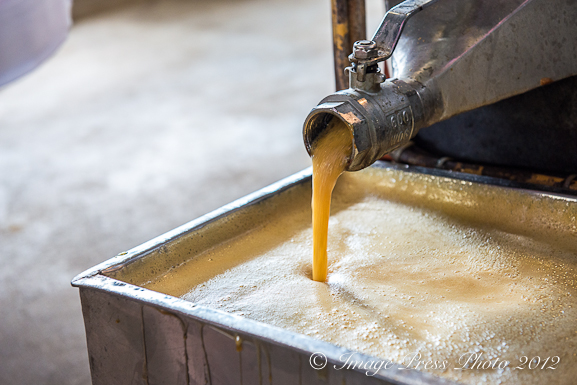
The bucket where the sorghum collects before it is pumped to be cooled and bottled
Muddy Pond Mill is not just a functioning business, it is also a gathering place for the community. Sherry told us that, “Older people come and sit all day and watch. They love to see it made and it brings back memories. It means a lot to them.” Sherry added, “The younger people have no idea what it really is and they come and learn about it.”
By midday, the entire family stops whatever they are doing and come in from the farms and fields to sit down and enjoy supper together. They congregate at the mill where the tables are set. The women arrive with steaming pans and bowls of food. Work at the mill stops and the Guenthers excuse themselves for this time of fellowship. In the background, the younger women sing hymns before blessing the meal. We stopped what we were doing out of respect for this family’s daily tradition.
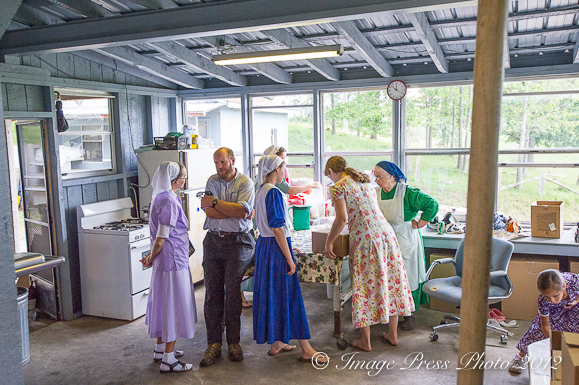
The family gathers at the mill throughout the day
We traveled to the foothills of Middle Tennessee to learn about the process of making sorghum. Instead, we learned about a way of life focused on simplicity and family. From the moment we turned onto Muddy Pond Road, life changed. It became less complicated. A people with a strong work ethic, a common purpose, shared religious beliefs, and a genuine sense of community made everything else outside of this world seem not quite so important.
When it was time to leave, we drove back down Muddy Pond Road. We passed young women in traditional Mennonite dress mowing the lawn, men on tractors tending to the fields, and stopped at a general store for a taste of sorghum ice cream. We turned off Muddy Pond Road and made our way back to Atlanta.
As we left “the community” and returned to our fast paced life with traffic, concrete, congestion, and tempers, we wondered which world is real. The folks at Muddy Pond are happy and self-sufficient. They work hard together and stay together. They take the time to share with others and enjoy life. A trip back in time is a good reminder for all of us about what the focus of our own lives should be.
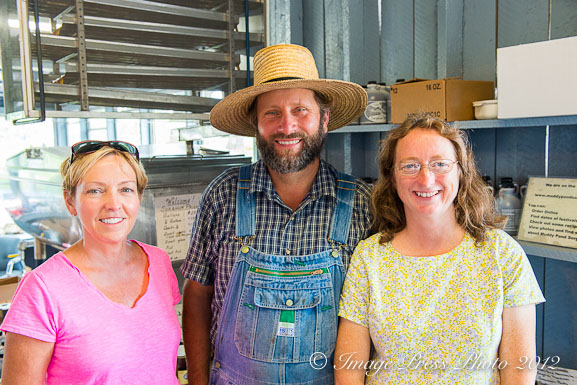
With Mark and Sherry Guenther
We appreciate the time that Mark and Sherry spent with us during their very busy day at the mill. It was a real pleasure to meet them along with Mark’s dad, John and brother, Ed. We learned so much more than just how to make sorghum.
Of course, we purchased a fresh jar of sorghum, several baked goods, and a cookbook during our visit to the mill. Sherry suggested several recipes from the book and I chose to make the cookies that we snacked on during the drive home. The recipe is for the Best Sorghum Cookies and it was right. Perfectly spiced and naturally sweetened, these chewy cookies are filled with the flavors of fall. You will not be able to eat just one.
Muddy Pond Sorghum is available in some Whole Foods Markets, at the Muddy Pond Mill, and at Guenther’s Variety Store in Muddy Pond. You can also order the product online from the Guenthers.
If you need a few other ideas for using sorghum, this sorghum butter from last November is fabulous on biscuits and we also mixed it with fresh herbs, basted, and smoked a chicken with it. The meat was incredibly juicy and tender and the flavor outstanding. Roasted Delicata Squash is a favorite side dish recipe of ours that is also made with sorghum butter.

Chewy, spicy, and perfect with a glass of cold milk
This content is protected under International Copyright Laws. Bunkycooks provides this content to its readers for their personal use. No part (text or images) may be copied or reproduced, in whole or in part, without the express written permission of bunkycooks.com. All rights reserved.
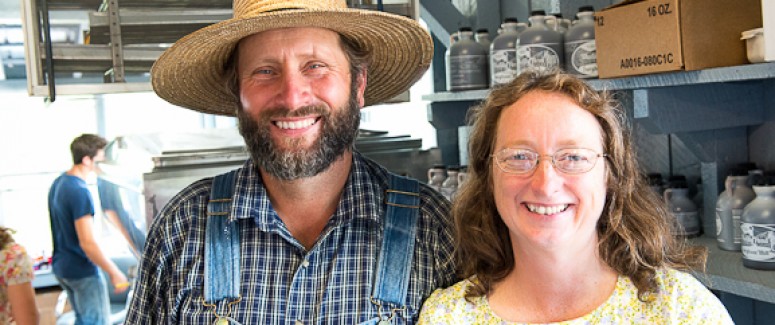
Best Sorghum Cookies
These cookies are soft and chewy. Be sure not to overbake. They also freeze well.
Ingredients:
1/2 cup margarine (I used unsalted butter)
1/2 cup vegetable shortening
1 1/2 cups sugar
1/2 cup sorghum
2 eggs, lightly beaten
4 cups flour
1/2 teaspoon salt
2 1/4 teaspoon baking soda
2 teaspoons ground ginger
1 1/2 teaspoons ground cloves
1 1/2 teaspoons ground cinnamon
Directions:
1. Preheat oven to 350 degrees.
2. In a large mixing bowl, cream margarine (or butter), shortening, and sugar. Beat in sorghum and eggs; set mixture aside.
3. In an another large bowl, combine flour, salt, baking soda, ginger, cloves, and cinnamon. Blend thoroughly with wire whisk.
4. Gradually mix flour mixture into creamed ingredients until dough is blended and smooth.
5. Roll dough into 1 1/2-inch balls. Dip tops in granulated sugar; place 2 1/2-inches apart on a greased cookie sheet. Bake at 350 degrees for 11 minutes. Do not overbake. Cool on wire rack.
Store in tightly covered container to maintain softness.
Recipe courtesy of the Sorghum Treasures Cookbook
The National Sweet Sorghum Producers and Processors Association